How stock markets are performing is a crucial question for many ‘listed’ companies either immersed in the construction industry or with close connections to the sector. Companies want to see a strong economy and escalating profits so that their publicly-issued shares will increase in value. This ‘micro’ view, however, takes a back seat to the much broader implications for construction when the share values of many companies, in a range of sectors, are climbing.
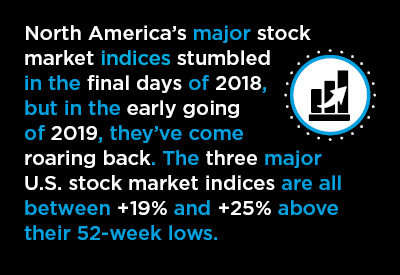
Equity values generally rise on better earnings. Better earnings, in turn, can be used to finance new projects. Buoyant valuations also make it easier for firms to raise funds through share offerings, reducing the need for loans, and providing additional funds for capital spending.
Strength in share price valuations also disperses outwards through mutual and pension funds to boost consumer spending. A big side benefit is heightened consumer and business confidence.
Also know that a new wrinkle has been added of late to the stock-market/construction-activity connection. In the recovery and expansion phase of U.S. economic growth that has been occurring over the past ten years, there has been a significant shift in the relationship between the Federal Reserve and America’s major stock markets. It seems that the Fed’s decisions about moving on interest rates have been more influenced by investor sentiment than in the past.
An ‘independent’ Fed is supposed to mainly concentrate on employment and inflation markers to establish its interest-rate policy-setting direction. In recent years, on several occasions, severe setbacks in share values have caused the Fed to divert from an announced hawkish path.
Along the construction pipeline, the level of and outlook for bank and mortgage interest rates have always been key determinants of whether under-consideration new projects in the residential and nonresidential space will be allowed, by decision-makers, to go ahead.
The health of Canada’s premier equity market, the Toronto Stock Exchange, often reflects how the resource sector is performing, although ‘financials’ also play a big role. When commodity prices, especially in the energy field, are displaying uplift, owners of extraction firms will be more positive in their assessments of potential major and often mega-sized construction projects.
Latest Month-End Closing Values:
North America’s major stock market indices stumbled in the final days of 2018, but in the early going of 2019, they’ve come roaring back. An earlier belief in continuing interest rate hikes has been downscaled. The consensus view now is that the Federal Reserve will put a long pause on further upward yield adjustments. And after a weak GDP performance north of the border in Q4 2018 (+0.4% annualized), the Bank of Canada may be more likely to cut rates than to raise them.
The three major U.S. stock market indices are all between +19% and +25% above their 52-week lows. They’re also flirting with reaching and surpassing their previous all-time peaks.
| INDEX | 52-WEEK LOW | 52-WEEK HIGH | YEAR AGO (MAR 30, 2018) |
MONTH AGO (FEB 28, 2019) |
Latest Month-end Closing Prices (mar 29, 2019) |
PER CENT CHANGE, LATEST VERSUS |
|||
| 52-WEEK LOW | 52-WEEK HIGH | YEAR AGO | MONTH AGO | ||||||
| Dow Jones Industrials NYSE (^dji) |
Dec 26 18 21,713 |
Oct 3 18 26,952 |
24,103 | 25,916 | 25,929 | 19.4% | -3.8% | 7.6% | 0.1% |
|
S & P 500 |
Dec 26 18 2,347 |
Sep 21 18 2,941 |
2,641 | 2,784 | 2,834 | 20.7% | -3.6% | 7.3% | 1.8% |
| NASDAQ (^ixic) |
Dec 24 18 6,190 |
Aug 30 18 8,133 |
7,063 | 7,533 | 7,729 | 24.9% | -5.0% | 9.4% | 2.6% |
| S & P/TSX Composite TSX (^gsptse) |
Dec 24 18 13,777 |
Jul 13 18 16,587 |
15,367 | 15,999 | 16,102 | 16.9% | -2.9% | 4.8% | 0.6% |
Securities Dealers Automated Quotations (NASDAQ), Toronto Stock Exchange (TSE) and Reuters.
Table: ConstructConnect.
Latest-Year Performances:
Graph 1 takes the closing value for the index in each of the past 12 months and calculates a percentage change versus March 2018’s closing value. In this manner, March 2018 becomes a common fixed base and the relative performances of the four major indices are easy to assess.
Unlike some previous months, however, when one index (often NASDAQ) clearly outperformed the others, the separation between the four indices at the end of the period, March 2019, is much tighter. NASDAQ once again did best (+9.4%), but the DJI (+7.6%) and S&P 500 (+7.3%) were not far behind, and even the TSX (+4.8%) showed decent improvement.
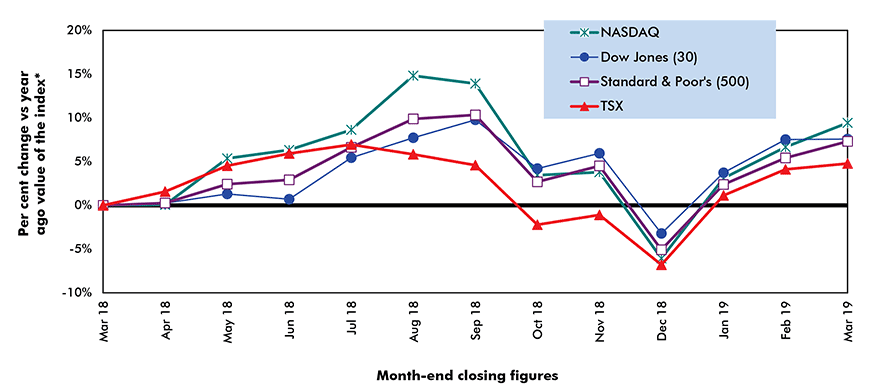
1) New York Stock Exchange – Dow-Jones Industrials (30);
2) New York Stock Exchange – Standard and Poor’s (S & P) (500);
3) National Association of Securities Dealers Automated Quotations – NASDAQ Composite Index;
4) Toronto Stock Exchange – S & P/TSX Composite.
Securities Dealers Automated Quotations (NASDAQ), Toronto Stock Exchange (TSE) and Reuters.
Chart: ConstructConnect.
Latest 10-Year Performances (i.e., Since Their Troughs):
Graph 2 applies the same principle as Graph 1, except that it employs February 2009 as its starting point. The month-end closing values for each of the four major indices are compared with their values in February 2009, which was when they all experienced their most recent troughs. In February 2009, the Great Recession was knocking the stuffing out of the economy.
While it’s true that there have been some recent periods of volatility in the indices, consider the following amazing longer-term results: over the past ten years, NASDAQ is +461%; the S&P 500, +286%; and the DJI, +267%. By comparison, the TSX is a disappointing +98%. While NASDAQ is up fivefold, the TSX is struggling to double.
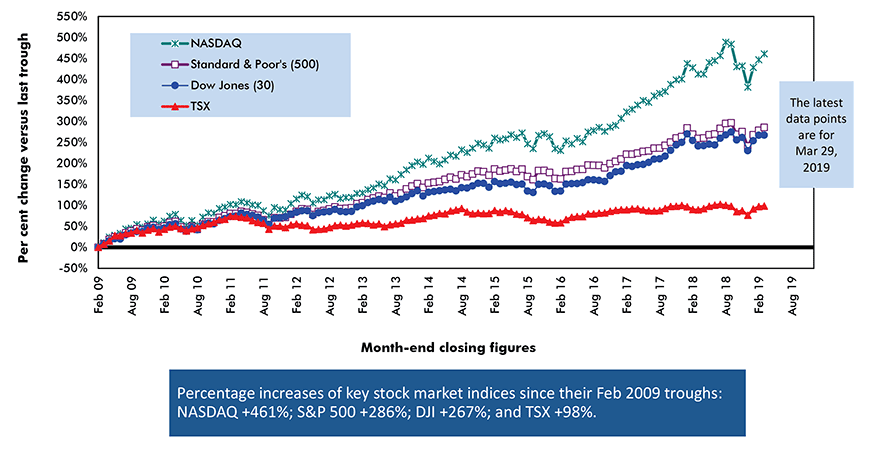
Securities Dealers Automated Quotations (NASDAQ), Toronto Stock Exchange (TSE) and Reuters.
Chart: ConstructConnect.
Other Key Stock Markets Indices:
Table 2 shows month-over-month (m/m) and year-over-year (y/y) results for some other major stock market indices in the U.S. and around the world. Only two of the indices have managed y/y advances, London’s FTSE (+3.1%) and STOXX Europe (+2.2%). The Russell 2000 index for ‘smaller cap’ stocks has been essentially flat, +0.7%.
Making predictions about stock market prices is not for the faint hearted. Who would have anticipated that London U.K.’s exchange would be +3.1% y/y, given all the uncertainty and turmoil that is presently on display daily concerning Brexit.
| Month-end | ||||||||
| Closing Value | Month/ | Year/ | ||||||
| Stock Index: | Mar 29 2019 | Month/ | Year | |||||
| Russell 2000 | 1,540.00 | -2.3% | 0.7% | |||||
| iShares MSCI Emerging Markets Index (EEM): | 42.92 | 1.1% | -11.1% | |||||
| iShares MSCI Emerging Markets Asia Index (EEMA): | 67.65 | 2.1% | -9.7% | |||||
| London FTSE 100 (^FTSE): | 7,279.00 | 2.9% | 3.1% | |||||
| German DAX 30 (^GDAXI) | 11,526.00 | 0.1% | -4.7% | |||||
| STOXX Europe | 37.44 | 2.5% | 2.2% | |||||
| Hong Kong Hang Seng (^HSI): | 29,051.00 | 1.5% | -3.5% | |||||
| Tokyo Nikkei 225 (^N225): | 21,206.00 | -0.8% | -1.2% | |||||
| Shanghai Composite Index (000001.SS) | 3,091.00 | 5.1% | -2.5% | |||||
| iShares MSCI Frontier 100 ETF for pre-emerging markets (FM): | 28.46 | -0.1% | -18.9% | |||||
Table: ConstructConnect.
4 Graphs Depicting Long-Term Histories of the Major Indices:
For reference, graphic representations of the long-term histories (since January 1991) of the DJI, S&P 500, NASDAQ and S&P/TSE are provided below.
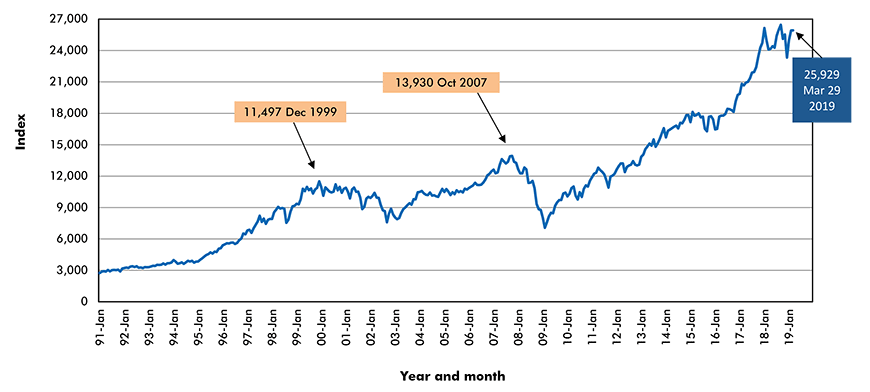
Securities Dealers Automated Quotations (NASDAQ), Toronto Stock Exchange (TSE) and Reuters.
Chart: ConstructConnect.
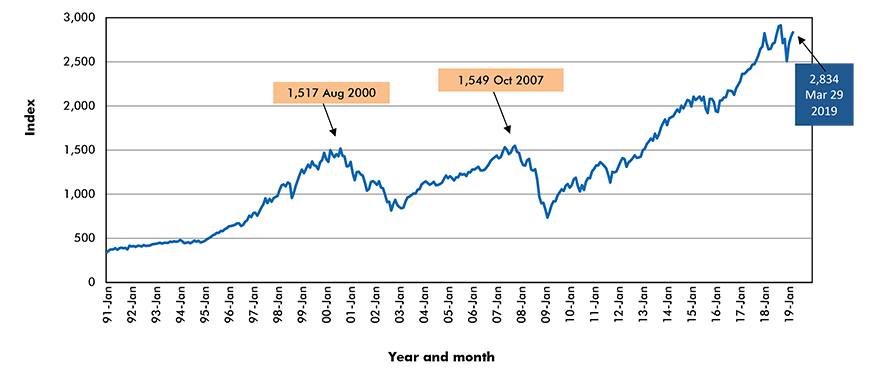
Securities Dealers Automated Quotations (NASDAQ), Toronto Stock Exchange (TSE) and Reuters.
Chart: ConstructConnect.
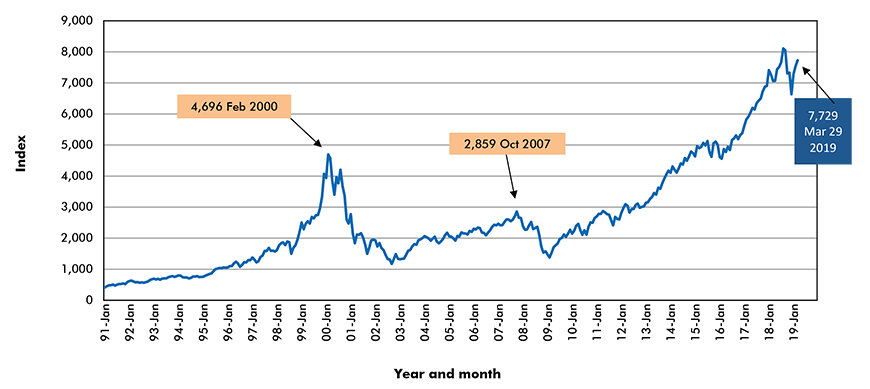
Securities Dealers Automated Quotations (NASDAQ), Toronto Stock Exchange (TSE) and Reuters.
Chart: ConstructConnect.
Toronto Stock Exchange
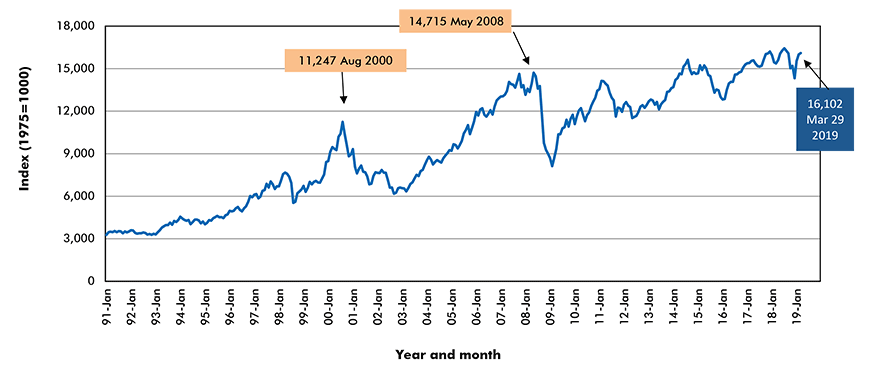
Securities Dealers Automated Quotations (NASDAQ), Toronto Stock Exchange (TSE) and Reuters.
Chart: ConstructConnect.











Recent Comments
comments for this post are closed